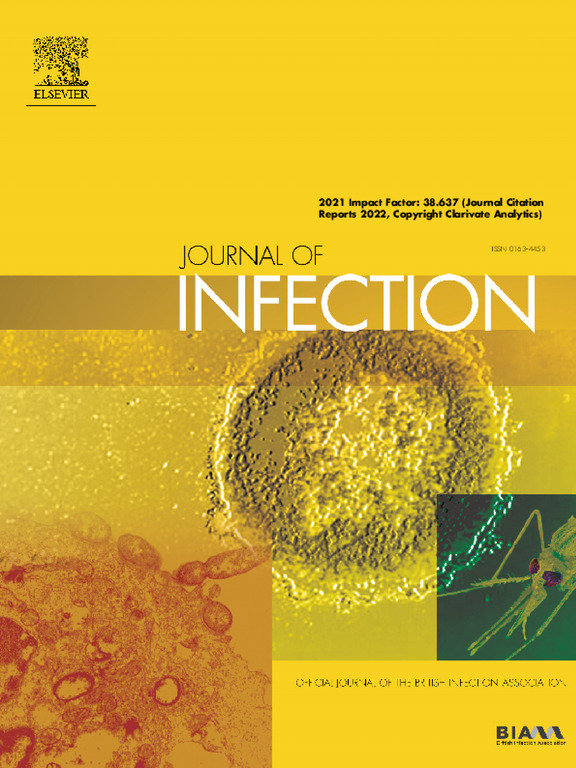A human-infecting H10N5 avian influenza virus: Clinical features, virus reassortment, receptor-binding affinity, and possible transmission routes
IF 14.3
1区 医学
Q1 INFECTIOUS DISEASES
引用次数: 0
Abstract
Background
In late 2023, the first human case caused by an H10N5 avian influenza virus (AIV) was diagnosed in China. H10Ny AIVs have been identified in various poultry and wild birds in Eurasia, the Americas, and Oceania.
Methods
We analyzed the clinical data of the H10N5 AIV-infected patient, isolated the virus, and evaluated the virus receptor-binding properties together with the H10N8 and H10N3 AIVs identified in humans and poultry. The genomic data of the human-infecting H10N5 strain and avian H10Ny AIVs (n = 48, including 16 strains of H10N3 and 2 strains of H10N8) from live poultry markets in China, during 2019–2021, were sequenced. We inferred the genetic origin and spread pattern of the H10N5 AIV using the phylodynamic methods. In addition, given all available nucleotide sequences, the spatial-temporal dynamics, host distribution, and the maximum-likelihood phylogenies of global H10 AIVs were reconstructed.
Findings
The first H10N5 AIV-infected human case co-infected with seasonal influenza H3N2 virus was identified. Unfortunately, the patient died after systematic treatments. The H10N5 virus predominantly bound avian-type receptor, without any known mammalian-adapted mutations. Phylodynamic inference indicated that the H10N5 AIV was generated by multiple reassortments among viruses from Korea and Japan, central Asia, and China in late 2022, acquiring the seven gene segments from H10N7 or other low pathogenic AIVs in wild Anseriformes, except for the PA gene from H5N2 AIVs in Domestic Anseriformes. The HA gene of the H10N5 virus belongs to the North American lineage, which was probably introduced into Asia by migratory birds, subsequently forming local circulation.
Interpretation
Unlike the human-infecting H10N3 and H10N8 AIVs acquiring six internal protein-coding genes from H9N2 AIVs in domestic poultry, the human-infecting H10N5 AIV was generated through multiple reassortments among viruses mainly carried by wild Anseriformes. Furthermore, worldwide distribution, inter-continental transmission, and genetic exchanges between Eurasian and North American lineages call for more concerns about influenza surveillance on H10Ny AIVs, especially in the flyway overlapping areas.
人感染H10N5禽流感病毒:临床特征、病毒重组、受体结合亲和力和可能的传播途径
背景:2023年底,中国确诊了第一例H10N5禽流感病毒(AIV)人间病例。H10Ny aiv已在欧亚大陆、美洲和大洋洲的各种家禽和野生鸟类中发现。方法:分析H10N5型aiv感染患者的临床资料,分离该病毒,并与在人和家禽中鉴定出的H10N8和H10N3型aiv一起评估病毒的受体结合特性。对2019-2021年中国活禽市场人感染H10N5型和禽感染H10Ny型aiv (n = 48,包括16株H10N3和2株H10N8)的基因组数据进行测序。采用系统动力学方法推测H10N5型AIV的遗传起源和传播模式。此外,基于所有可用的核苷酸序列,重建了全球H10 aiv的时空动态、宿主分布和最大似然系统发育。结果:发现首例H10N5型人感染H3N2季节性流感病毒合并感染病例。不幸的是,病人在经过系统治疗后死亡。H10N5病毒主要结合禽类型受体,没有任何已知的适应哺乳动物的突变。系统动力学推断表明,H10N5病毒是在2022年底由韩国和日本、中亚和中国的病毒多次重组而产生的,除PA基因来自国内anserformes的H5N2 AIV外,其余7个基因片段来自H10N7或其他野生anserformes的低致病性AIV。H10N5病毒的HA基因属于北美谱系,可能是由候鸟传入亚洲,随后形成局部循环。解释:与人感染的H10N3和H10N8型AIV在家禽中获得来自H9N2型AIV的6个内部蛋白质编码基因不同,人感染的H10N5型AIV是通过主要由野生anserformes携带的病毒之间的多次重组而产生的。此外,H10Ny aiv的全球分布、洲际传播以及欧亚和北美谱系之间的基因交流,需要更多地关注流感监测,特别是在飞行路线重叠地区。
本文章由计算机程序翻译,如有差异,请以英文原文为准。
求助全文
约1分钟内获得全文
求助全文
来源期刊

Journal of Infection
医学-传染病学
CiteScore
45.90
自引率
3.20%
发文量
475
审稿时长
16 days
期刊介绍:
The Journal of Infection publishes original papers on all aspects of infection - clinical, microbiological and epidemiological. The Journal seeks to bring together knowledge from all specialties involved in infection research and clinical practice, and present the best work in the ever-changing field of infection.
Each issue brings you Editorials that describe current or controversial topics of interest, high quality Reviews to keep you in touch with the latest developments in specific fields of interest, an Epidemiology section reporting studies in the hospital and the general community, and a lively correspondence section.
 求助内容:
求助内容: 应助结果提醒方式:
应助结果提醒方式:


